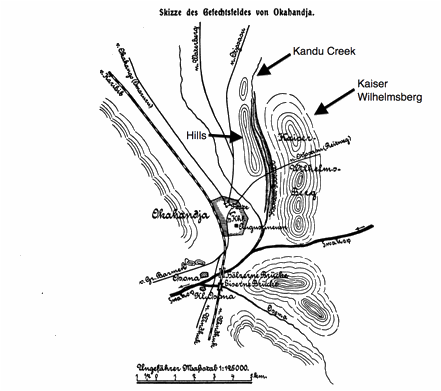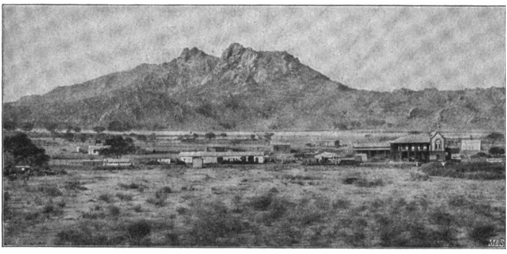While the Battle of Okahandja was of strategic importance, it was too inherently one-sided for a tactically interesting historical scenario. Accordingly, there is no Okahandja scenario in "The Herero War" book.
However, because of its strategic significance the battle definitely merits a description - especially in English, since all other detailed accounts are in German. I therefore decided to write this standalone essay - separate from "The Herero War" book - about the first battle of the Herero War.
Roy S. Jones
The Battle of Okahandja1
(January 28, 1904)
Okahandja was of great strategic importance in German South-West Africa. The colony’s rail line, that began at Swakopmund on the coast and terminated at the colonial capital Windhuk, passed through Okahandja. As long as Okahandja was in Herero hands, Windhuk was effectively cut off from reinforcement and resupply by rail.
The task of driving Herero forces from Okahandja fell to Hauptmann Viktor Franke’s 2nd Feldkompagnie (Kompagnie Franke). As of January 20th Franke’s force consisted of 6 officers, 2 doctors, and 110 Schutztruppe infantry. In addition, two guns were attached to the Kompagnie: a C/73 Feldgeschütz (field gun) and a Gebirgsgeschütz (mountain gun), with the gun crews totaling 27 men2.
Okahandja station, and the rail line passing through it, lay west of Kandu Creek (a tributary of the Swakop River). However, the station and the surrounding terrain were dominated by the 1,675-meter high Kaiser Wilhelmsberg, which was strongly occupied by the Hereros and was located east of the creek. Clearing Herero riflemen from the Kaiser Wilhelmsberg was therefore crucial if Okahandja were to be secured.
Map of the Okahandja Battlefield.
(Generalstab, pg. 46; English annotations by Roy Jones)

Assaulting the Kaiser Wilhelmsberg, however, appeared to offer the prospect of an incredibly tough fight for the Germans. The Hereros defended the Kaiser Wilhelmsberg with strong forces fighting from mountainside entrenchments. Directly in front of the mountain was Kandu Creek, with its steep banks and dry sandy bed. On the other side of the creek, on the western shore, were low hills occupied by Hereros.
Finally, the terrain in front of the Kaiser Wilhelmsberg was full of thick thorn bushes that at many places required an attacker to crawl on his belly.

The Okahandja Rail Station, with the Kaiser Wilhelmsberg in the background. (Generalstab, pg. 45)
In spite of the obstacles described above, Kompagnie Franke was able to take the low hills on the western shore after a short firefight. The Germans then rested. The Gebirgsgeschütz was brought forward despite the difficult terrain; this is a testament to the mobility of a mountain gun, since that same terrain prevented the Germans from moving their C/73 field cannon forward3. The Gebirgsgeschütz began to shell the east-shore entrenchments and individual Hereros started to flee. The Germans then went into Kandu Creek, and found themselves in hip-deep, shifting sand! Movement was slow and cumbersome. This could have been a deathtrap for Kompagnie Franke, if it were not for one little peculiarity: the Germans had inadvertently jumped into an area of dead ground, where the Hereros could not see them or shoot at them! The Kompagnie thus traversed the creek slowly and arduously, but in complete safety.
Once on the opposite (i.e., eastern) shore, the Germans received sparse and ineffective Herero fire because of the support of the mountain gun. Kompagnie Franke was thus able to ascend the Kaiser Wilhelmsberg uninterruptedly, seizing one set of fieldworks after another. It reached the summit to find numerous Herero dead and wounded, vast quantities of supplies, and many horses: the Germans had apparently captured the main, headquarters lager of the Okahandja Detachment!
Because of the difficult-to-traverse terrain (thorn bushes, hip-deep sand, a 1,675-meter height), the battle was long: six hours. German losses, however, were very light: only 3 wounded out of a force of 145 (a 2% casualty rate).
Three main factors contributed to the low German casualty rate:
(a) the fortuitous presence of dead ground;
(b) artillery fire that was unusually effective in inflicting casualties on entrenched Herero troops;
(c) Hereros who fled after offering little resistance (the morale effect of the artillery casualties may have contributed to this).
Thus despite the Hereros’ fortifications and the rough terrain, the Battle of Okahandja was essentially a German cakewalk. The Germans were able to rest and catch their breath after taking the lower hills, then cross Kandu Creek without being seen much less shot at, and then assault the Kaiser Wilhelmsberg without being shot at effectively and after many of the Herero troops had already fled or been killed by artillery fire.
While the Battle of Okahandja was of strategic significance in the ‘big picture’, it was too inherently one-sided for a well-balanced and tactically interesting historical scenario. Accordingly, while it definitely merits a description, there is no Okahandja scenario in this book.
The engagement at Okahandja was the last time the Germans would find fighting the Hereros easy going. Within a week, on February 4th, 1904, while struggling to retake their garrison town of Omaruru, Kompagnie Franke would discover just how tough assaulting a fortified Herero position could be.
1. This account of the Battle of Okahandja is derived from Generalstab, pp. 44 – 47.
2. Order of Battle from Generalstab, pg. 37.
3. Generalstab, pg. 46. This incident is the basis for the Mountain Gun rule in the Artillery & Machine Guns chapter of "The Herero War" book.
SOURCES
Die Kämpfe der deutschen Truppen in Südwestafrika. Auf Grund amtlichen Materials bearbeitet von der Kriegsgeschichtlichen Abteilung I des Großen Generalstabes. Erster Band (von 2) : Der Feldzug gegen die Hereros; Berlin, Ernst Siegfried Mittler und Sohn, 1906 (hereafter, Generalstab)